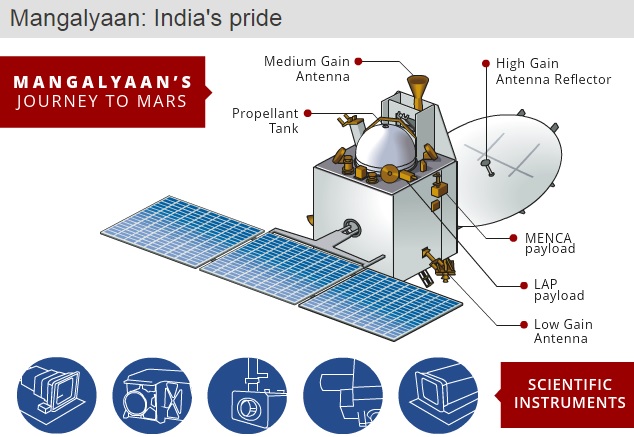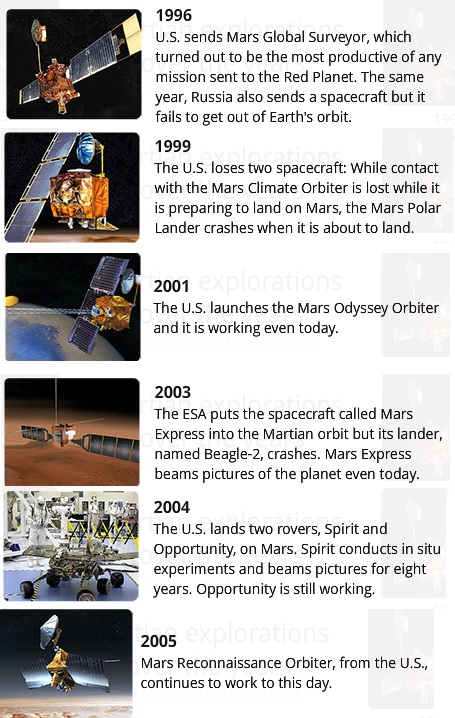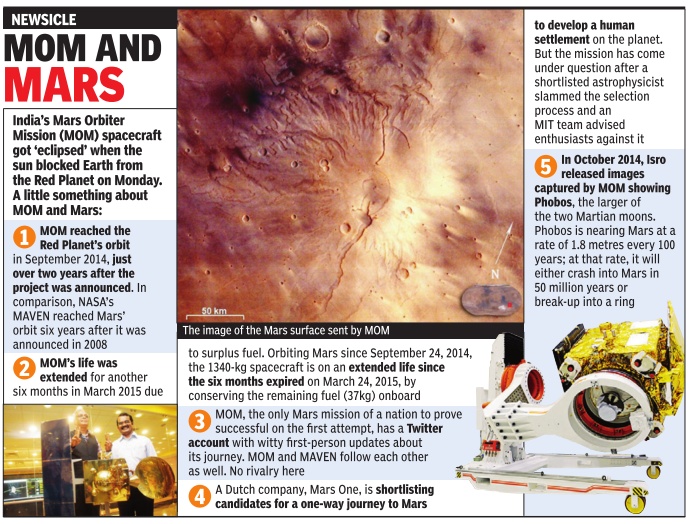Mars Orbiter Mission




This is a collection of articles archived for the excellence of their content.
|
Timeline
Mars Orbiter Mission: Timeline
Here's the timeline of Mars Orbiter Mission.
05-11-2013: PSLV-C25, in its twenty fifth flight, successfully launches Mars Orbiter Mission Spacecraft from SDSC SHAR Sriharikota
07-11-2013: The first orbit raising manoeuvre of Mars Orbiter Spacecraft, starting at 01:17 hrs(IST) on Nov 07, 2013 successfully completed
08-11-2013: The second orbit raising manoeuvre of Mars Orbiter Spacecraft, starting at 02:18:51 hrs(IST), with a burn time of 570.6 seconds successfully completed. The observed change in Apogee is from 28814 km to 40186 km
09-11-2013: The third orbit raising manoeuvre of Mars Orbiter Spacecraft, starting at 02:10:43 hrs(IST) on Nov 09, 2013, with a burn time of 707 seconds successfully completed. The observed change in Apogee is from 40186km to 71636km.
11-11-2013: In the fourth orbit-raising operation conducted on Nov 11, 2013 the apogee (farthest point to Earth) of Mars Orbiter Spacecraft was raised from 71,623 km to 78,276 km by imparting an incremental velocity of 35 metres/second (as against 130 metres/second originally planned to raise apogee to about 100,000 [1 lakh] km). The spacecraft is in normal health.
12-11-2013: Fourth supplementary orbit raising manoeuvre of Mars Orbiter Spacecraft, starting at 05:03:50 hrs(IST) on Nov 12, 2013, with a burn Time of 303.8 seconds successfully completed. The observed change in Apogee is from 78276km to 118642km.
16-11-2013: The fifth orbit raising manoeuvre of Mars Orbiter Spacecraft, starting at 01:27 hrs(IST) on Nov 16, 2013, with a burn Time of 243.5 seconds successfully completed. The observed change in Apogee is from 118642km to 192874km.
01-12-2013: Medium Gain Antenna of the Mars Orbiter Spacecraft is powered for long distance communication, subsequent to successful Trans Mars Injection (TMI) manoeuvre. Trans Mars Injection (TMI) operations completed successfully. The liquid engine burn time was 1328.89 sec and the imparted incremental velocity was 647.96 m/sec.
02-12-2013: Spacecraft has travelled a distance of 5,36,000 km by 17:00 hrs (IST) of Dec 2, 2013. It has crossed the distance to Moon's orbit around Earth (mean distance 3,85,000 km) this morning.
04-12-2013: Spacecraft has traversed beyond the Sphere of Influence (SOI) of Earth extending about 9,25,000 km at around 1:14 hrs (IST) on Dec 4, 2013.
11-12-2013: The first Trajectory Correction Manoeuvre (TCM) of Spacecraft was carried out successfully at 06:30 hrs (IST) by firing the 22 Newton Thrusters for a duration of 40.5 seconds. The spacecraft is travelling at a distance of about 29 lakh (2.9 million) km away from Earth.11-02-2014: 100 Days Of Mars Orbiter Spacecraft.
09-04-2014: Mars Orbiter Spacecraft Crosses Half Way Mark of its Journey.
12-06-2014: The second Trajectory Correction Manoeuvre (TCM-2) of India's Mars Orbiter Spacecraft was successfully performed on June 11, 2014 at 1630 hrs IST. TCM-2 was performed by firing the spacecraft's 22 Newton thrusters for a duration of 16 seconds.
16-09-2014: Time-tagged commands to execute Mars Orbit Insertion (MOI) uploaded.
17-09-2014: Uploading of commands for Fourth Trajectory Correction Manoeuver and test-firing of Main Liquid Engine (scheduled for Sep 22, 2014) is in progress.
22-09-2014: Test Firing of Main Liquid Engine of Mars Orbiter Spacecraft is successful.
24-09-2014: Mangalyaan enters Mars orbit.
Important factoids
India created history on September 24, becoming the first country to successfully get a spacecraft into the Martian orbit on its maiden attempt. Here are 10 things you should know about the Mars Orbiter Mission or Mangalyaan. 1. Before India, various countries have launched Mars missions, but out of the 51 attempts, only 21 were successful. India now joins the Martian club that comprises the US, Russia and the European Space Agency.
2. US space agency Nasa was one of the first to congratulate Isro on its success. Prime Minister Narendra Modi gave a congratulatory speech highlighting the success and hardwork of the Isro scientists.
3. After the Mars mission, the Indian space agency will work together with Chinese space scientists to prepare a roadmap for a series of missions to be implemented together. Isro chief's K Radhakrishnan's tenure will come to an end by the time of 2014. The first three months of 2015 might see Radhakrishnan practice Kathakali.
4. A methane sensor will look for sources of the gas. While the Mars colour camera clicks away, a thermal infrared spectrometer will study heat emission, minerals and soil on Mars.
5. India's MOM is the cheapest inter-planetary mission. It cost about a tenth of Nasa's Mars mission Maven that entered the Martian orbit on September 22. PM Narendra Modi applauding Indian scientists had said,"Hollywood movie Gravity costs more than our space mission."
6. The spacecraft structure and propulsion hardware configurations are similar to Chandrayaan 1, which was country’s first successful robotic lunar probe. Specific improvements and upgrades were made for a Mars specific mission.
7. The most important experiment is to check for the presence of methane that can indicate just what kind of life existed on Mars, if at all.
8. The orbiter, after a 300-day flight, has covered a distance of 680 million kilometres to reach the Red Planet's orbit.
9. As it goes around Mars on an elliptical orbit with the closest point around 420km and the farthest around 80,000km, MOM will employ five equipment that collectively weight 15kg to do scientific studies.
10. The spacecraft trajectory would be tracked from Nasa's Jet Propulsion Laboratory facilities at Goldstone (US), Madrid (Spain) and Canberra (Australia).
Amount spent on Mars Orbiter Mission
Chethan Kumar, Isro spend on MOM wasn't even Rs 450cr, Nov 18 2016 : The Times of India
The Indian Space Research Organization (Isro), which, according to all official claims, is reported to have spent Rs 450 crore on the Mars Orbiter Mission (MOM), did not even spend the whole of that shoestring budget.
An austere Isro managed to save Rs 2.61 crore which it promptly returned to the Centre, reaffirming MOM to be the world's cheapest mission to the red planet, at a cost of Rs 447.39 crore.
Documents revealing the audited expenditure of all Isro projects in the last five years reveal that MOM isn't the only such project.
Though Isro sought Rs 892.69 crore to launch the GSAT-15 communication satellite, the Centre released on ly Rs 830.88 crore. But Isro, which launched GSAT-15 last November, completed the project using just Rs 806.4 crore, saving Rs 24.48 crore. Similarly, it had sought Rs 897.94 crore for GSAT-16 but got only Rs 865 crore and the space agency went on to complete the project with Rs 864.12 crore.
“Unlike the Mars mission, which was a one-time project when cleared, the GSAT programme envisages launching several more satellites. Therefore, the money saved from its launch is with Isro to be used for future satellites,“ a senior official said.